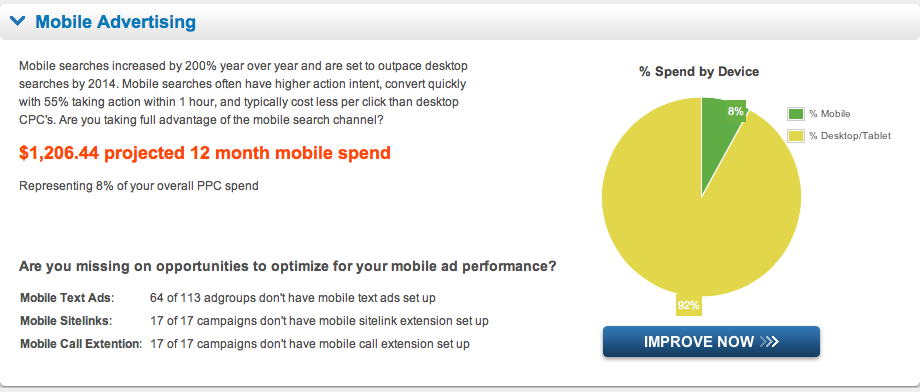Earlier this week our friends over at Wordstream launched their new and updated AdWords Grader Plus and we thought we’d take a look at what’s changed. For those of you interested in our previous thoughts on the grader Eric wrote a review of Wordstream’s AdWords Grader back in November 2012.
What does the AdWords Grader do?
A quick recap for those of you not wanting to read Eric’s article linked above is that the AdWords Grader is a tool that uses masses of data to compare your account to others in your industry and give you a percentage score for how well you match up. It looks at things like impression share, negative keywords, quality scores, click-through rates and the amount of activity happening in your account on a daily basis (are you an active PPC manager?). You can then use this data to find the holes in your PPC account – where are you miles behind your competition? – and to adjust your strategy and approach to fix these problem areas.
What’s new with AdWords Grader Plus?
Wordstream have added three big improvements to the grader. Probably the most important is the Performance Tracker that lets you see how your account grades out every month and compare historical performance trends. Every month the Grader takes a snapshot of your account and gives you a new percentage grade and also keeps track of some of your main metrics.
The second addition to the Grader is a new “Mobile Advertising” section that helps you to judge how well your account incorporates mobile best practices. Much like a lot of the Grader, the value of this section is not in direct recommendations but in reminding you of where exactly your account stands and what you should add to your to-do list. It breaks out your projected mobile spend – this lets you know how much you should be focusing on mobile (“oh man I’m going to spend $200,000 on mobile this year, should probably make sure that it’s well optimized!”). You can also see what percentage of your overall traffic comes from mobile.
Notice in the above example that about half of my ad groups are missing mobile preferred text ads (something I recently wrote about being very important). I’m also missing mobile Sitelinks in all my campaigns (now added to the to-do list), however I’m going to ignore Mobile Call Extensions as it’s not important for my account to have them differentiated from Computers and Tablet.
The third major update for Wordstream was an update to the Benchmarks used to judge your account. With changes to the Quality Score algorithm, average CPCs and CTRs it makes sense that the data used to judge your account needed an update. Wordstream uses data from over $3 billion worth of AdWords spend, meaning this is some of the best performance comparison data you can get outside of Google.
What we like
The Performance Tracker is a really useful tool for us as an agency. Seeing how an account stands when we bring it in is useful: Where does it stand against the competition? What are the major problem areas? Then we can also use it as a yardstick for how effectively we’re managing the account – Are things improving month to month against benchmarks? Are we spending enough time in the account.
The main value of Wordstream’s Grader has always been in suggesting areas for improvement rather than telling you exactly what you need to do. This is the case for the new Mobile section – it highlighted a couple of account shortcomings for my mobile strategy and helped me add to my to-do list.
What could be improved
While Wordstream draws on a ton of data – the scores can still be a little misleading. Sometimes your strategy can go against what are considered best practices – I’m deliberately only running A/B tests with my ads right now. I don’t need more than two per ad group. I might be running less than my competition but who’s to say that my very focused testing schedule is worse than a set it and forget it competitor with 3 live ads? I also scored just 45% for landing pages for having fewer than the competition (only 17 compared with the 45 I’m told I should have), even though my landing pages are great and look much better than those of my competition – it’s obviously tough for a tool to make these qualitative judgments. The mobile strategy section is helpful but still a little basic. I’d like to know how my mobile click-through and conversion rates match up.
Overall thoughts
If you’re looking for the quickest and cheapest way to audit your PPC account and get a pretty good overview of where you stand in your industry, look no further than the AdWords Grader. These recent updates have added a new layer of usefulness to the tool and sharpened up the existing features. However, for a deeper look into your account and an analysis of your PPC strategy you still can’t beat doing your own thorough audit.




